
Truck driver news is constantly evolving, with changes in regulations, technological advancements, and industry challenges shaping the daily lives of truckers. Whether you’re a seasoned driver or just starting in the trucking world, staying informed about the latest developments can help you navigate the road ahead.
In this article, we’ll cover key updates in the trucking industry, including regulatory changes, safety measures, technological advancements, and economic trends affecting truck drivers.
1. Latest Regulatory Updates for Truck Drivers
Regulations in the trucking industry are constantly changing to ensure safety, efficiency, and sustainability. Here are some of the most significant updates:
1.1 Hours of Service (HOS) Adjustments
- The Federal Motor Carrier Safety Administration (FMCSA) has revised HOS rules to provide greater flexibility to drivers.
- Recent changes allow for split sleeper berth time and modifications to the 30-minute rest break requirement.
- These updates aim to reduce driver fatigue while allowing more operational flexibility.
1.2 Speed Limiters on Commercial Trucks
- The FMCSA has proposed a mandate requiring speed limiters on large trucks to enhance road safety.
- This rule could potentially limit truck speeds to 65 mph, reducing accident risks but also affecting delivery timelines.
1.3 Drug and Alcohol Testing Updates
- The Drug and Alcohol Clearinghouse now has stricter reporting and compliance measures.
- Employers must conduct annual queries on their drivers, ensuring that only sober and safe operators are on the road.
2. Trucking Industry Economic Trends
The trucking industry plays a crucial role in the global supply chain, and economic trends significantly impact drivers’ earnings and job stability.
2.1 Freight Rates and Fuel Prices
- Fuel prices have been fluctuating due to global oil market conditions, directly affecting trucking operational costs.
- Freight demand has seen ups and downs, influenced by consumer spending patterns and supply chain disruptions.
2.2 Driver Shortages and Employment Trends
- The trucking industry is facing an ongoing driver shortage, with companies increasing wages and offering bonuses to attract new talent.
- Younger drivers and women are being encouraged to enter the profession to fill the workforce gap.
2.3 Autonomous Trucks and Their Impact on Jobs
- The rise of autonomous trucks could reshape the industry, but human drivers will still play a key role in overseeing operations.
- Many companies are investing in AI and automation to improve delivery efficiency and safety.
3. Safety Measures for Truck Drivers
Safety remains a top priority in the trucking industry, with new regulations and technologies helping to reduce accidents and fatalities.
3.1 New Truck Safety Technologies
- Advanced Driver Assistance Systems (ADAS) are being integrated into trucks, helping with lane-keeping, collision avoidance, and automatic braking.
- Dashcams and telematics systems are being widely adopted to monitor driver behavior and prevent risky actions.
3.2 Winter Driving Precautions
- As colder months approach, truckers are advised to check their vehicles for proper tire pressure, antifreeze levels, and braking systems.
- Many trucking companies offer winter safety training to help drivers navigate icy roads.
3.3 Mental and Physical Health of Truckers
- Long hours on the road can impact both mental and physical health, making it essential for drivers to take regular breaks, stay hydrated, and exercise when possible.
- Companies are increasingly offering wellness programs to support truck drivers’ health.
4. Technology Innovations in Trucking
Technology is transforming the trucking industry, improving efficiency, safety, and sustainability.
4.1 Electric and Hybrid Trucks
- Major manufacturers are rolling out electric and hybrid truck models to reduce carbon emissions and fuel costs.
- Companies like Tesla, Volvo, and Daimler are leading the charge in electric truck development.
4.2 Smart Logistics and AI
- Artificial intelligence is helping companies optimize routes, reduce idle time, and improve fuel efficiency.
- Smart logistics platforms allow drivers to receive real-time traffic updates and better manage delivery schedules.
4.3 Blockchain in Freight Management
- Blockchain technology is being used to improve transparency in freight transactions.
- It enhances security, reduces paperwork, and prevents fraudulent activities in the trucking industry.
5. Challenges Facing Truck Drivers Today
Despite advancements and regulatory improvements, truckers still face significant challenges.
5.1 Work-Life Balance Issues
- Long-haul drivers spend extended periods away from home, impacting their personal lives and relationships.
- Some companies are offering flexible schedules to improve work-life balance.
5.2 Rising Operational Costs
- The cost of truck maintenance, fuel, and insurance continues to rise, squeezing profits for independent truckers.
- Many drivers are exploring fuel-efficient driving techniques to mitigate costs.
5.3 Increased Competition from Gig Economy Services
- Companies like Amazon Flex and Uber Freight are offering alternative trucking solutions, changing the landscape of freight delivery.
- Traditional truck drivers may need to adapt to new business models to stay competitive.
6. Future of the Trucking Industry
Looking ahead, the trucking industry is poised for significant transformations.
6.1 More Sustainable Practices
- Green trucking initiatives are gaining momentum, with regulations pushing for lower emissions and better fuel efficiency.
- Companies are investing in eco-friendly trucking solutions to meet sustainability goals.
6.2 Changing Workforce Demographics
- More young drivers are entering the industry, and there’s an increasing push to recruit more women into trucking roles.
- Training programs are evolving to cater to the next generation of truckers.
6.3 Expansion of 5G and Connectivity
- With 5G networks expanding, truckers will have access to faster and more reliable communication tools.
- Enhanced connectivity will improve fleet management and real-time tracking capabilities.
Conclusion
The trucking industry is rapidly evolving, with new regulations, technological advancements, and economic shifts shaping the future. Staying informed with the latest truck driver news can help drivers adapt to changes, improve safety, and take advantage of new opportunities.
Whether you’re a trucker, fleet owner, or industry professional, keeping up with industry trends is crucial for long-term success. As we move forward, embracing innovation and adapting to new challenges will be key to sustaining a thriving trucking sector.

